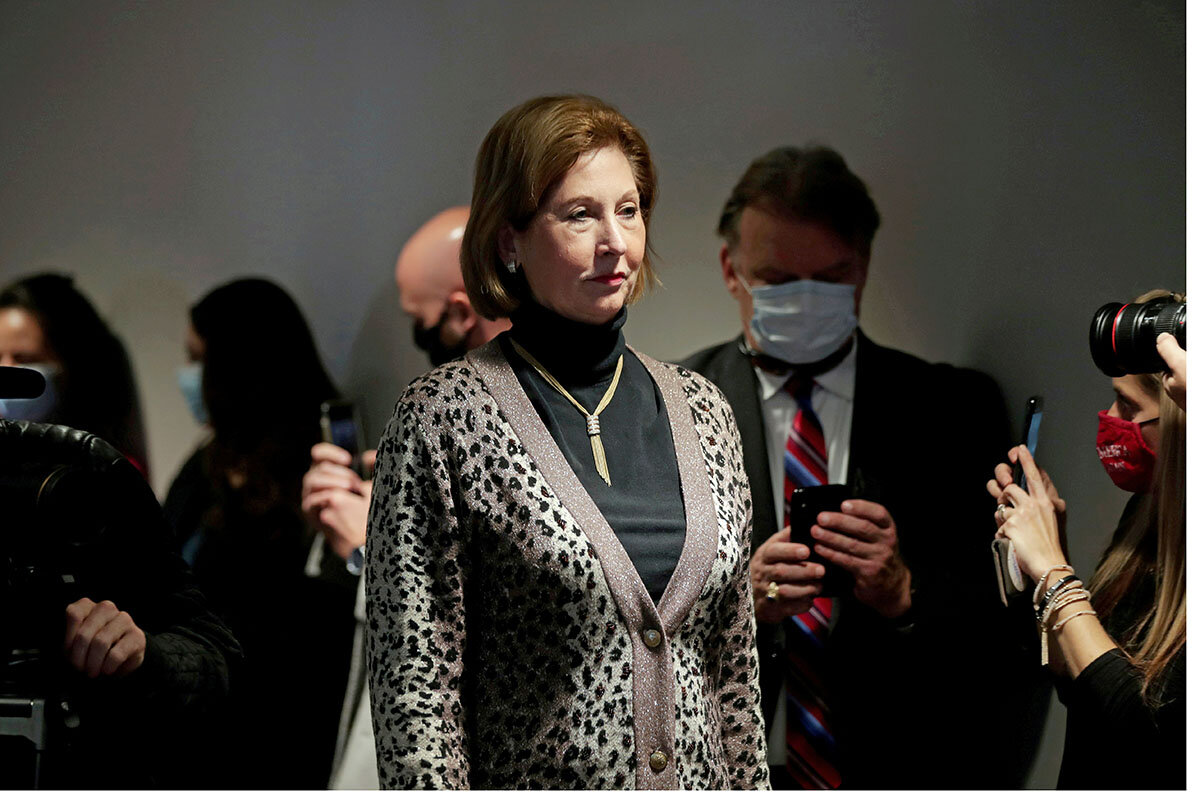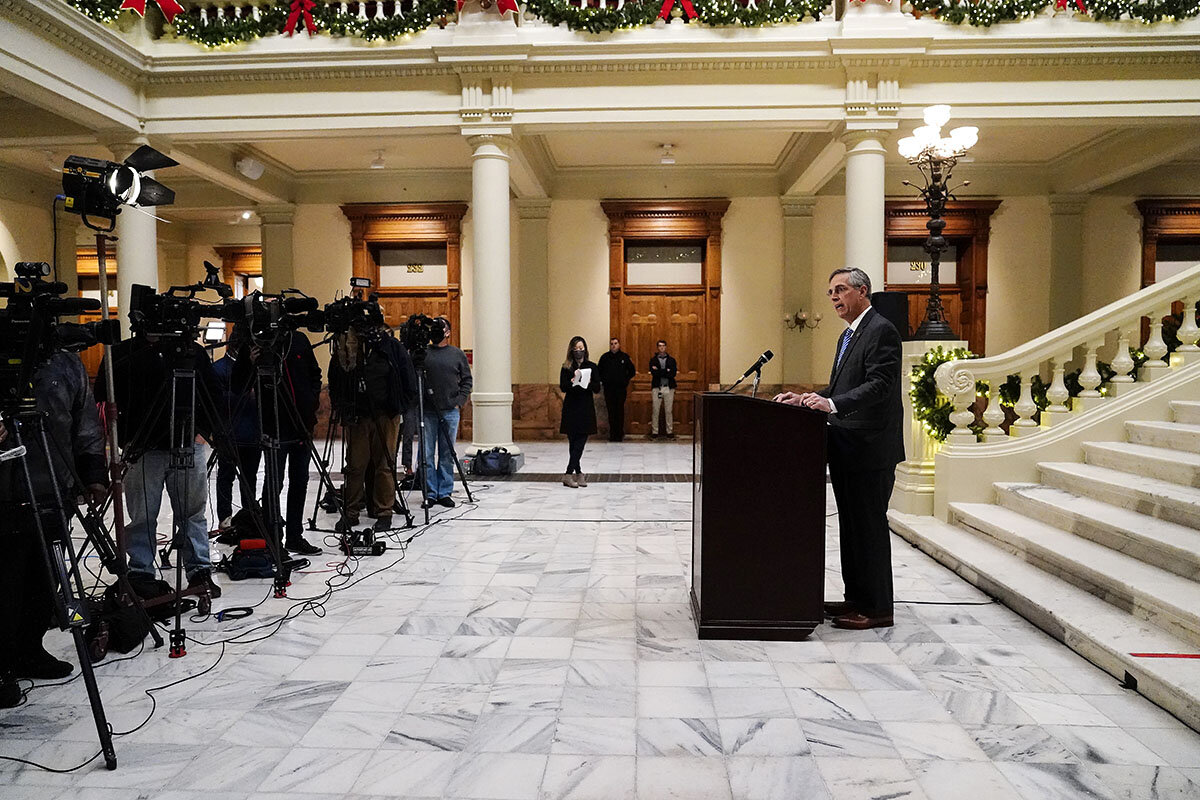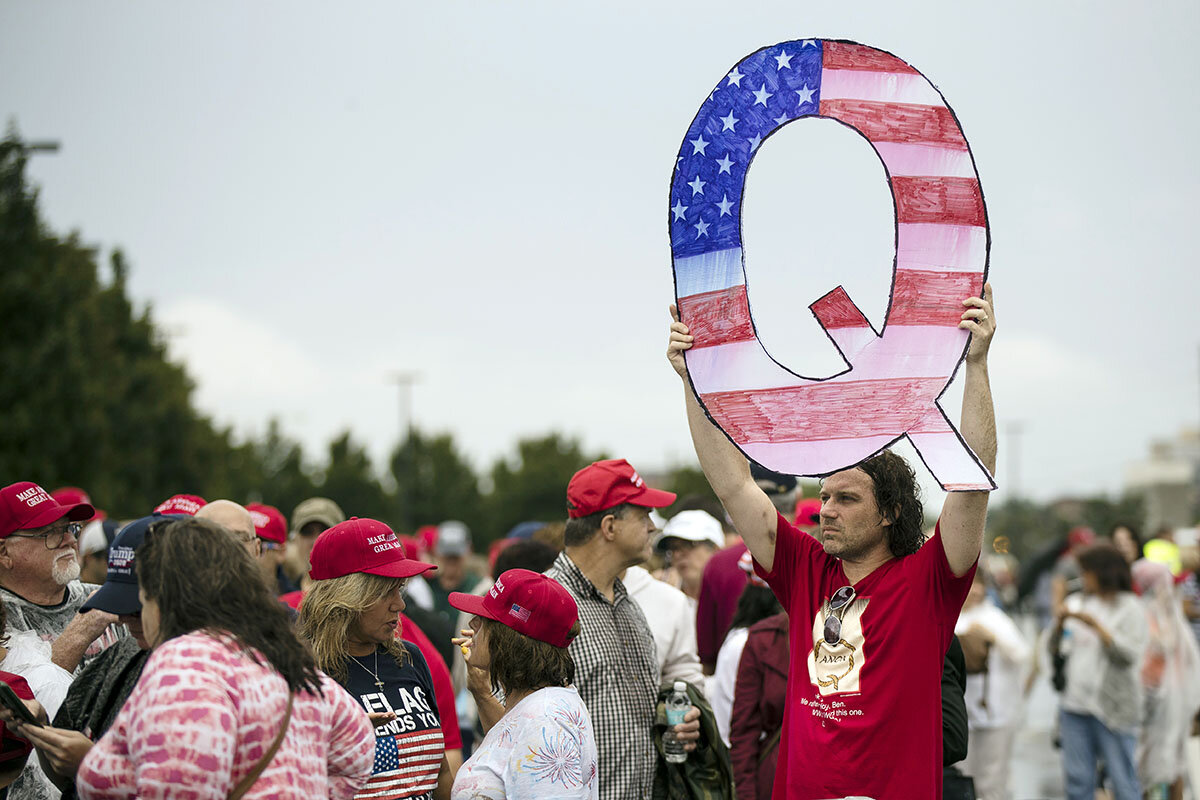‘If you can keep it’: Where next for a strained democracy
Loading...
After the extraordinary events of the past five months, American democracy may be under stress like never before in the modern era.
The great machine of governance established by the Constitution in 1788 has long been beset by underlying problems such as partisanship, gridlock, and disinformation. Then in November 2020 an incumbent president threw a match on this tinder: a false claim that the election was stolen, and that despite certified counts electing his opponent, in fact he had won.
This lie has since rooted itself in part of the nation’s body politic, drawing support from hundreds of elected Republican officials. A mob smashed into the U.S. Capitol on Jan. 6 to stop the purported “steal.” Former President Donald Trump’s evidence-free assertion about the election was a dangerous seed that can no longer be unplanted – a little over a third of U.S. voters, and three-quarters of Republicans, say they don’t think President Joe Biden won legitimately, according to one recent poll.
Why We Wrote This
Growing political polarization, economic inequality, executive power run rampant, and populism: These are the four tests to determine whether a democracy is under threat. For the first time, the U.S. meets all four. First in a series.
That false belief endures despite more than 60 court cases heard by more than 90 judges, including Trump appointees, and despite Trump administration officials, including the attorney general and the top cybersecurity official, saying the elections were secure and there was no credible evidence of widespread fraud. One of the most vocal boosters of the lie, lawyer Sidney Powell, is defending herself against billion-dollar libel lawsuits, saying “no reasonable person” would believe her “wild accusations” and “outlandish claims.”
Meanwhile, in the election’s aftermath, the parties are embracing very different ideas about which direction democracy should take. Republicans are all-in on enacting new voting restrictions, Sen. Ted Cruz of Texas recently told a group of GOP state lawmakers. If Democrats succeed in pushing through far-reaching election legislation currently before the Senate, Republicans won’t win elections for a generation, Senator Cruz said.
Democrats increasingly believe that the nation’s governance structure is tilted against them and that they do not win seats commensurate with their numbers, due to the Electoral College and other factors. They’re pushing for new states and other major changes to flip what they perceive as a structural imbalance.
America is now enmeshed in “an uncivil war that pits red against blue, rural versus urban, conservative versus liberal,” President Biden said in his inaugural address.
Most voters agree with that assessment, according to polls. Only 16% believe democracy is thriving in the United States, according to a survey from The Associated Press/NORC Center for Public Affairs Research. Some 45% think U.S. democracy isn’t functioning properly.
Where do we go from here? One piece of good news is that democracy’s troubles have sparked a sharp increase in thinking and writing about how Americans might bolster their 233-year democratic experiment.
Many experts think that patching cracks is only part of the solution. Another part might be building democracy in the first place – addressing the inequalities of representation and participation that have blighted the nation since its founding. Also needed: getting elected officials to face and try to fix the nation’s real social and economic problems.
“The work of rejuvenating and restoring our democracy is going to have to focus on all levels of government. This is an all-hands-on-deck affair,” says William Howell, a professor in American politics at the University of Chicago.
American coup d’état
White supremacists powered the mob. They were angry about the demise of the world as they had known it, including a loss of political power they felt rightfully theirs.
Their leaders called on them to take it back. So they planned something that could only be called a coup d’état and attacked a citadel of their opponents.
The year was 1898, not 2021, and the place was Wilmington, North Carolina. But the similarities between the 19th-century insurrection, in which a mob of white men overthrew an elected biracial government in Wilmington, and the Jan. 6 insurrection, in which a mob stormed the U.S. Capitol to stop the counting of Electoral College votes, are inescapable, says Suzanne Mettler, professor of American institutions at Cornell University.
That’s what she kept thinking while watching scenes of the Capitol riot.
“There are so many parallels,” Professor Mettler says.
The most obvious similarity is the refusal to accept an election. President Trump’s unwillingness to acknowledge that he lost the 2020 presidential vote, and his monthslong effort to overturn the results, were “among the most abnormal and important events of the Trump presidency,” according to Bright Line Watch, a group of experts that monitors U.S. democratic practices.
This denial was clearly anti-democratic. “Democracy is a system in which parties lose elections,” according to a pithy definition from New York University political scientist Adam Przeworski.
Another similarity between the events of 1898 and 2021 is the extensive planning involved in operations. While some organization took place at the grassroots, it was political leaders in both cases who rallied and aimed the crowds at their destination. At least a dozen Capitol rioters facing federal charges have said they stormed the building because their president told them to.
Race was also a driving factor in both events. It was more central to Wilmington, but white supremacist symbols, signs, and supporters were present in Washington as well.
Democracy survived past sieges
The Wilmington riot figures largely in “Four Threats: The Recurring Crises of American Democracy,” a book published last year by Professor Mettler and co-author Robert Lieberman of Johns Hopkins University. It was a major example of the backsliding from racial progress that occurred throughout the post-Civil War South.
The prewar white aristocracy of Wilmington, largely Southern Democrats, had seethed while Black Republicans and white populists rose to elected power in the decades after 1865. In 1898 they acted, enlisting white militia groups to help retake the city. On Nov. 10 armed white people rampaged through Black neighborhoods, killing hundreds. The building of the Black-owned Daily Record newspaper was burned to the ground, and the police chief and other officials were driven out of town at gunpoint.
President William McKinley declined to intervene in the coup. In coming months, the insurrectionists changed state voting laws, making access to the ballot subject to new restrictions such as literacy tests and poll taxes.
“That means the Democrats became the dominant party with very little competition,” Professor Mettler says.
Democracy was under siege, as it has been at crucial times throughout American history. In “Four Threats,” Professor Mettler and her co-author look at five crises: the 1790s and its ferocious conflict between the Federalists of President John Adams and the Republicans of Thomas Jefferson and James Monroe, the 1850s and the run-up to the Civil War, the 1890s and the end of Reconstruction, the 1930s and the rise of an imperial presidency amid economic crisis, and the 1970s and the maturation of weaponized presidential power amid Watergate.
After analyzing the events of these periods, four distinct types of disruption emerge, says Professor Mettler. These are the book’s four threats, which separately or in concert are inimical to the building of democracy.
The first is political polarization – in Adams’ time, Federalists and Republicans so disliked one another that they often lived in different neighborhoods and attended different churches. Second is the question of who is a full member of society, which touches directly on the racism and nativism that have stained American history. Third is economic inequality, which has weakened belief in democracy from the Gilded Age to today. Fourth is growing executive power, which strains the Constitution itself.
Sometimes it takes only one of these factors to threaten American democracy, according to Professors Mettler and Lieberman. Sometimes a number of them combine to deepen a crisis, as they did in the 1850s and 1890s.
But now they’re all present in the country to one degree or another, says Professor Mettler.
“We’ve never had all four threats together at the same time. It says to me democracy is really endangered now,” she says.
Closely divided electorate
The U.S. is currently in the midst of one of the most competitive eras in the nation’s political history. The 2020 presidential election was the ninth in a row in which the popular vote margin was less than 10 percentage points – a record.
Neither party received a vote of confidence from the American people in last November’s vote. Democrat Joe Biden won the presidency, but Democrats did worse than expected in House races. The Senate is split 50-50, with control determined by Vice President Kamala Harris’ vote.
This outcome is unsurprising given that neither the Republican nor Democratic Party has surpassed a 50% approval rating in the U.S. since 2009.
“Whatever the shortcomings of our representational institutions, they accurately reflect a country that remains divided down the middle between the two parties,” wrote Frances Lee, professor of politics and public affairs at Princeton University, in an after-election analysis.
In this context politics itself on the national level has become hypercompetitive, as both sides have every incentive to fight for every ballot. Both sides see the basic rules of democracy as their key to future victory, tweeted New America senior fellow Lee Drutman earlier this month.
But the two parties are taking very different approaches to the current focus of their struggle over rules: voting rights. Democrats are pushing a mammoth catch-all bill at the national level that would mandate automatic registration, expand early and mail-in voting, establish a public financing option for congressional campaigns, and establish ethics rules for Supreme Court justices, among other things.
Republicans are generally working at the state level in legislatures where they have the power to enact voting restrictions. In Georgia the GOP has already passed a bill that tightens voter ID requirements for absentee ballots, limits drop boxes, and most importantly, shifts some electoral oversight powers to the state legislature.
GOP lawmakers are pushing similarly restrictive bills in at least 43 states. As justification, many state Republicans cite uncertainties about the 2020 election, driven by the false accusations about fraud made by Mr. Trump and his allies.
Both sides in this struggle may be trying to gain an advantage over the other, but one side has been far more aggressive and even anti-democratic in its tactics: Republicans. Much of this is rooted in Mr. Trump’s continued grip on the party and his few-holds-barred effort to flip the election results.
For instance, Brad Raffensperger, the Georgia secretary of state who refused to accede to Mr. Trump’s attempt to alter the state’s vote count, is the target of Trump-led revenge efforts to block his reelection. The Georgia voting bill has already stripped his position of some of its powers.
But Republican hardball tactics are more than an expression of Mr. Trump’s singular personality. They’re also a result of the party’s transition into an outlet for America’s rising populist emotions, says Professor Howell of the University of Chicago.
The GOP is increasingly the party of those who feel Black Lives Matter, the #MeToo movement, a perceived “cancel culture,” and other sweeping social and cultural changes are turning America into a country they don’t recognize.
Issues, policy proposals, budgets, and other mundane aspects of government aren’t what populism is about.
“Populism is a posture of opposition, and it expresses itself by sowing divisions, fomenting anger, and destroying democratic norms and procedures,” says Professor Howell, co-author of “Presidents, Populism, and the Crisis of Democracy” with Terry Moe of Stanford University.
Populism’s global rise
Populism is a political identity whose adherents believe they represent the real people of a nation. This identity is often channeled through a charismatic strongman, powering their political fortunes.
Populism in America long predates Mr. Trump. It’s prevalent now in many European countries. It thrives amid government failures – the inability to address unauthorized immigration, globalization, automation, and other problems of the modern age.
But former President Trump is a classic populist leader, according to Professor Howell. His basic message is that everything is broken, illegitimate, or rigged. In that context, supporters see his pushback on election results as a kind of valor, a good fight against a system that is otherwise stacked against them.
“When that sensibility takes hold in a public, it is not coincidental that the attractiveness of democracy dwindles,” says Professor Howell.
How to counter this trend? It’s simple, write Professors Howell and Moe in their book – or at least, simply defined. Make government work again. Address the process and procedure problems that have made Washington hardened.
“A big part of the reason populism has taken hold in North American politics is our government has failed to solve problems our public wants to see solved,” says Professor Howell.
Admittedly, that’s a steep mountain. Congress seems incapable of working on more than one thing at a time. Partisanship blocks almost all solutions. Those that pass are ungainly beasts, loaded with carve-outs and compromises and extraneous provisions that dilute their ability to address their original purpose.
Professors Howell and Moe’s solution to this seems counterintuitive: Dial up presidential power.
Presidential administrations generally are energetic, unified, and more action-oriented than the legislature. The trick is keeping them in check.
“Our argument is: How do we think about leveraging the problem of presidential leadership while keeping in mind the effect that demagogues can pose to American democracy? That’s the goal,” says Professor Howell.
Specifically, presidents should be given universal fast-track authority, he argues. That means the nation’s chief executive should be able to introduce bills on any subject, and Congress would be required to vote them up or down, without any modifications, within a set time, and without filibusters. (This general approach already applies with trade agreements.)
On the restraint side of the ledger, the Department of Justice and intelligence agencies should be insulated from direct presidential control, Professors Howell and Moe write – perhaps through the use of bipartisan appointed boards, such as the Federal Reserve Board, which oversees monetary policy. President Trump’s attempts to meddle with prosecutorial and intelligence decisions at the DOJ showed the danger of leaving these powerful agencies under one man’s control.
The writers would also restrict the numbers of presidential appointees in departments and agencies. This could protect against overall politicization of the executive branch.
“Deep state” versus the Oval Office
But perhaps the problem shadowing American democracy is not the unworkability of government per se, but a clash within the executive branch, one at the center of so many Trump presidency uproars: the “deep state” versus the Oval Office.
On one side was a bureaucracy and permanent government deep in expertise and personnel, pursuing its own interests and derided by Mr. Trump as a secretive cabal working to undermine him. On the other was a chief executive who embraced the all-powerful image of the “unitary executive” theory held by former Attorney General William Barr and other conservatives.
“When somebody’s president of the United States, the authority is total,” said President Trump at a press conference last year.
During Mr. Trump’s term in office, the U.S. discovered that much of the insulation protecting this deep state was based on norms, not laws or some more formal protections of deference. In addition to the DOJ seeking to act as the president’s personal attorney in a case where alleged sexual assault occurred before he was in office, other examples of that norm-busting included firing bureaucrats for testifying before Congress and berating health officials during a pandemic.
Combined with his attacks on congressional powers and prerogatives, this exposed gaping holes in American governance.
“That really is where Trump upended the apple cart,” says Stephen Skowronek, a political scientist at Yale University and co-author of “Phantoms of a Beleaguered Republic: The Deep State and the Unitary Executive,” with John Dearborn of Yale and Desmond King of the University of Oxford.
To fix the problems exposed in the last four years, Congress should find creative ways to induce the executive branch to join it in cooperative methods of day-to-day governance, according to Professor Skowronek.
This could take the form of bolstering the independence of inspectors general, creating new executive branch offices, establishing independent boards and commissions, and so forth.
“Congress could do a lot of different things,” he says.
Democracy is a muscle
The day after delegates officially signed the Constitution and adjourned in 1787, an inquisitive woman asked Benjamin Franklin whether the new nation would be a monarchy or a republic.
“A republic, if you can keep it,” Franklin famously replied.
This answer gets at one of the essential points about the nature of U.S. governance – democracy is a muscle. It needs exercise to remain strong, and cooperation among citizens and civic institutions to back it up when threatened.
The good news in America is that as democracy has been stressed in recent years, the courts, the media, and brave individuals have proved resilient enough to stand up and protect it. Democratic culture in the country runs deep – perhaps deeper than in other places where it has begun to wobble in recent years.
But the hard truth is that U.S. democracy has long been a work in progress, slowly accepting excluded groups such as women and Black people, sometimes rolling back gains already made, producing authoritarian areas little influenced by democratic ideals.
The passage of the Voting Rights Act in 1965 put the U.S. on the path to becoming a full democracy. But there is still progress to be made. Protecting democracy may involve building it in the first place, as well.
“The most important thing is to try to strengthen the pillars of democracy,” says Professor Mettler. “The rule of law, strong election administration, protected voting rights. Those things are most crucial.”









